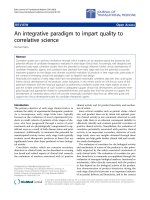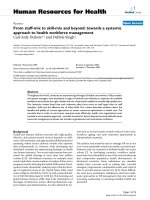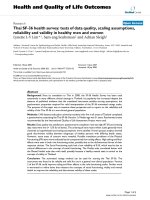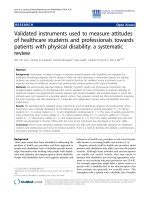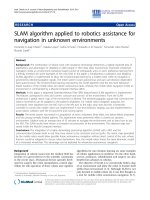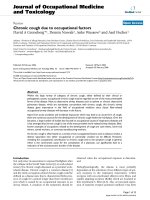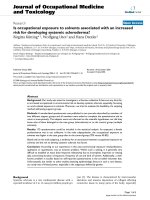báo cáo hóa học:" From HIV diagnosis to treatment: evaluation of a referral system to promote and monitor access to antiretroviral therapy in rural Tanzania" doc
Bạn đang xem bản rút gọn của tài liệu. Xem và tải ngay bản đầy đủ của tài liệu tại đây (268.92 KB, 9 trang )
BioMed Central
Page 1 of 9
(page number not for citation purposes)
Journal of the International AIDS
Society
Open Access
Research
From HIV diagnosis to treatment: evaluation of a referral system to
promote and monitor access to antiretroviral therapy in rural
Tanzania
Ray Nsigaye
1
, Alison Wringe*
2
, Maria Roura
2
, Samuel Kalluvya
3
,
Mark Urassa
1
, Joanna Busza
2
and Basia Zaba
2
Address:
1
Tazama Project, National Institute of Medical Research, Mwanza, Tanzania,
2
Centre for Population Studies, London School of Hygiene
and Tropical Medicine, London, UK and
3
HIV/AIDS Unit, Bugando University College of Health Sciences, Mwanza, Tanzania
Email: Ray Nsigaye - ; Alison Wringe* - ; Maria Roura - ;
Samuel Kalluvya - ; Mark Urassa - ; Joanna Busza - ;
Basia Zaba -
* Corresponding author
Abstract
Background: Individuals diagnosed with HIV in developing countries are not always successfully linked
to onward treatment services, resulting in missed opportunities for timely initiation of antiretroviral
therapy, or prophylaxis for opportunistic infections. In collaboration with local stakeholders, we designed
and assessed a referral system to link persons diagnosed at a voluntary counselling and testing (VCT) clinic
in a rural district in northern Tanzania with a government-run HIV treatment clinic in a nearby city.
Methods: Two-part referral forms, with unique matching numbers on each side were implemented to
facilitate access to the HIV clinic, and were subsequently reconciled to monitor the proportion of
diagnosed clients who registered for these services, stratified by sex and referral period. Delays between
referral and registration at the HIV clinic were calculated, and lists of non-attendees were generated to
facilitate tracing among those who had given prior consent for follow up.
Transportation allowances and a "community escort" from a local home-based care organization were
introduced for patients attending the HIV clinic, with supportive counselling services provided by the VCT
counsellors and home-based care volunteers. Focus group discussions and in-depth interviews were
conducted with health care workers and patients to assess the acceptability of the referral procedures.
Results: Referral uptake at the HIV clinic averaged 72% among men and 66% among women during the
first three years of the national antiretroviral therapy (ART) programme, and gradually increased following
the introduction of the transportation allowances and community escorts, but declined following a national
VCT campaign. Most patients reported that the referral system facilitated their arrival at the HIV clinic,
but expressed a desire for HIV treatment services to be in closer proximity to their homes. The referral
forms proved to be an efficient and accepted method for assessing the effectiveness of the VCT clinic as
an entry point for ART.
Conclusion: The referral system reduced delays in seeking care, and enabled the monitoring of access to
HIV treatment among diagnosed persons. Similar systems to monitor referral uptake and linkages between
HIV services could be readily implemented in other settings.
Published: 11 November 2009
Journal of the International AIDS Society 2009, 12:31 doi:10.1186/1758-2652-12-31
Received: 19 July 2009
Accepted: 11 November 2009
This article is available from: />© 2009 Nsigaye et al; licensee BioMed Central Ltd.
This is an Open Access article distributed under the terms of the Creative Commons Attribution License ( />),
which permits unrestricted use, distribution, and reproduction in any medium, provided the original work is properly cited.
Journal of the International AIDS Society 2009, 12:31 />Page 2 of 9
(page number not for citation purposes)
Background
HIV testing services have expanded rapidly in many devel-
oping countries in order to reach ambitious targets for
antiretroviral therapy (ART) coverage [1]. However, the
potential for testing services to act as a gateway to HIV
treatment can be met only if individuals diagnosed with
HIV are subsequently linked to onward care and treat-
ment services in a timely manner. Delays in registering at
HIV treatment clinic services following an HIV diagnosis
can lead to late initiation of prophylactic treatment
against opportunistic infections or ART, potentially result-
ing in poorer prognoses for patients and an additional
clinical burden on overstretched health services [2].
In many settings, HIV services are currently organized
such that there are a great deal more HIV testing points
than treatment clinics, with diagnosed persons from sev-
eral testing sites theoretically linking to each HIV treat-
ment centre. The World Health Organization has
repeatedly acknowledged the importance of strengthen-
ing links between HIV testing and HIV treatment sites,
stating that explicit mechanisms are necessary to promote
referral to onward medical and psychosocial support for
those testing positive [3,4]. Simple methods for monitor-
ing onward referral rates are particularly important in the
context of provider-initiated testing and counselling and
prevention of mother to child transmission services, and
for monitoring subsequent access to HIV-related services,
thus ensuring that ethical concerns about routine testing
strategies are addressed [5].
Although international guidelines have emphasized that
improved referral mechanisms are essential for promoting
and monitoring entry to HIV services [6,7], few referral
tools have been developed, and as a result there is a pau-
city of data on the number of persons who are successfully
linked with treatment services following an HIV diagno-
sis. Nevertheless, emerging evidence from projects
involved in referring HIV-diagnosed persons to HIV clin-
ics in Tanzania has suggested rates of referral uptake as
low as 14%, representing missed opportunities for timely
HIV care and ART initiation [8]. Similarly low rates of
referral uptake at HIV clinics have been noted following
diagnoses made at voluntary counselling and testing
(VCT) services that are provided through mobile outreach
clinics [9]. In this case, diagnoses are made conveniently
close to patients' homes, but the HIV treatment clinic may
be far away, and after the mobile VCT service has moved
on, there is no-one left for patients to consult. Indeed, in
terms of accessing treatment following an HIV diagnosis,
transportation costs have been identified as an important
barrier to reaching these services [10,11], with allowances
rarely provided at the point of diagnosis.
The effectiveness of referral systems between the various
echelons of the health system in sub-Saharan African
countries has been explored in relation to other condi-
tions, with several studies focusing on reasons for non-
adherence to referral advice or analyses of health systems
inefficiencies when patients are treated at higher level
facilities than necessary [12-15]. However, few studies
have reported rates of referral uptake, with the exception
of two studies of "down referrals" of HIV and TB patients
from hospitals to health centres, which indicated an over-
all attrition rate between facilities of approximately 30%
[16,17]. The most commonly cited reasons for poorly
functioning referral systems include systemic factors, such
as inadequate training, poor quality referral letters or a
lack of feedback between facilities [13,16,17]. Further-
more, patient-level factors, including economic or oppor-
tunity costs and preferences for, or proximity to, certain
facilities, have also been shown to influence uptake of
referral advice [12,13,15].
Until effective referral systems for HIV treatment are more
widely implemented, it is difficult to evaluate how effec-
tive or equitable different HIV testing sites are in terms of
enabling access to onward care and treatment services
[18], or to devise locally relevant, low-cost interventions
to improve referral uptake. In order to maximize the ben-
efits of HIV testing, simple and robust referral systems are
therefore needed to promote timely access to treatment
services for infected patients, enable delays and equity in
the uptake of referral appointments to be monitored, and
facilitate communication between different HIV service
providers so that low rates of referral uptake can be docu-
mented and acted upon.
In this context, we piloted a new method for monitoring
referral rates between a VCT clinic in a rural area in north-
west Tanzania and a government-run HIV treatment clinic
in a zonal referral hospital, 20 km away in Mwanza City.
We also documented the role of transport allowances and
a volunteer escort from a local home-based care (HBC)
organization on rates of referral uptake. This paper
describes the implementation of this referral system and
reports on the lessons learned that enabled us to improve
access to HIV treatment in the community, and that can
be readily adopted elsewhere.
Methods
Study setting
In Tanzania, the national AIDS control programme began
providing free ART in public sector referral hospitals, and
subsequently rolled out treatment to district hospitals and
health centres [19]. HIV testing is provided by more than
500 static and mobile VCT clinics and through "opt-out"
or provider-initiated testing and counselling, which has
Journal of the International AIDS Society 2009, 12:31 />Page 3 of 9
(page number not for citation purposes)
been implemented in health care facilities and antenatal
clinics since 2007 [6,7].
Monitoring and evaluation (M&E) of the national ART
rollout is coordinated by the Tanzanian Commission for
AIDS, focusing on routine data collection for key indica-
tors, including numbers of individuals initiating ART. In
selected areas of the country, such as the TAZAMA study
site, specialized M&E research is being undertaken to doc-
ument the uptake and demographic impact of ART in the
context of a long-term HIV cohort study [20].
This study, located in Kisesa ward in the rural north-west
part of the country, collects longitudinal demographic
and serological surveillance data, providing a rich back-
ground against which M&E of HIV service uptake can
occur. An integral aspect of the project's activities is to
pilot data collection tools that can be adopted nationally
for monitoring access to HIV services.
Development of the referral system
The process of designing the referral system was led by
researchers from the Tanzanian National Institute of Med-
ical Research, and included consultations with stakehold-
ers involved in referring diagnosed HIV-infected clients
from VCT to the HIV treatment clinic. These included VCT
counsellors, HIV clinic staff, representatives from a local
HBC programme (the Lutheran Church-run "Tumaini",
which supported HIV-infected persons in the area), and
the national AIDS control programme. Other local
projects referring HIV-positive persons to the HIV treat-
ment clinic (such as a microbicide development study)
also participated to avoid duplicating efforts and develop-
ing parallel systems which might increase the workload of
clinic staff.
The aims of the referral system as defined during these
consultations were: (1) to ensure that HIV-positive VCT
clients were formally directed and linked to HIV treatment
services; and (2) to monitor the proportion of HIV-posi-
tive VCT clients who were successfully linked to the HIV
clinic, in order to assess the effectiveness of the VCT clinic
as a "gatekeeper" to the HIV treatment programme.
The "Tumaini" programme, now operating under the
name "Tunajali" provided home-based care in the area
and conducted tracing visits among those of its clients
who do not take up referral appointments. During the
study period, two home-based care volunteers were
recruited from each village and received a small monthly
stipend of approximately US$8. From early 2006,
Tumaini was also able to provide volunteer community
escorts to accompany newly diagnosed patients from the
local VCT centre to the HIV treatment clinic. Transporta-
tion allowances (approximately US$2 for a return trip)
were also provided for patients to attend the HIV treat-
ment clinic from early 2006 and were managed by the
VCT counsellors.
Development of the referral forms
The content and format of the forms that were used to
facilitate and document referral rates were developed after
reviewing existing referral forms from other African set-
tings [21], and were piloted during 2005. The final version
of the referral form consisted of two detachable parts, with
matching, unique numbers on each side to facilitate sub-
sequent reconciliation of the two parts.
One side included basic socio-demographic information
about the referred person and the referral date, and was
given to the patient to present at the HIV treatment clinic.
This section was completed by registration nurses at the
HIV clinic, and included the date of the patient's registra-
tion, allowing the delay between referral and registration
to be calculated. By additionally recording the unique
patient identifiers assigned by the HIV clinic on this sec-
tion, referral data could be subsequently linked to the data
recorded in patients' HIV clinic files.
The remaining part of the form also included the patient's
socio-demographic information, and was retained by the
referring party. The unique VCT identifier allocated by the
counsellors for each patient was recorded on this slip to
enable referral data to be subsequently linked to the VCT
data. A template of the referral forms can be downloaded
from
. Referral slips were
regularly collected from the VCT clinic and the HIV treat-
ment clinic, and reconciled by a clinical research officer
using a data-entry programme that generates standard
anonymized monthly reports. All referral slips were stored
in a locked cupboard to ensure patient confidentiality.
Quantitative methods
Data were analysed using Stata 10 (StataCorp, College Sta-
tion, Texas, USA). The proportion of diagnosed clients
who were referred to the HIV treatment clinic and the pro-
portion of referred patients that subsequently registered at
the HIV treatment clinic were calculated, stratified by sex
and time period. Delays in registering at the HIV treat-
ment clinic following a referral were calculated by sub-
tracting the date of registration from the date of referral.
Cross tabulations and chi square tests were conducted to
assess for associations between sex or time period and
uptake of a referral or registration at the HIV treatment
clinic.
Qualitative methods
In order to explore the acceptability of the referral system,
we conducted in-depth interviews with 11 health care
workers involved in referring and receiving patients at the
Journal of the International AIDS Society 2009, 12:31 />Page 4 of 9
(page number not for citation purposes)
HIV treatment clinic 18 months after introducing the
referral procedures. Within the context of a wider qualita-
tive study exploring access to HIV services [22,23], we also
conducted 42 in-depth interviews and four focus group
discussions with referred patients to elicit their experi-
ences of using the referral system. The focus group discus-
sions and in-depth interviews were recorded with prior
consent from participants and then transcribed, translated
into English, and entered into NVIVO7 for analysis. A
coding scheme was derived from the data by assigning
codes to major concepts mentioned by the participants
that were related to the referral scheme.
Ethical approval
Ethical approval for the study was obtained from the Med-
ical Research Coordinating Committee (Tanzania) and
London School of Hygiene and Tropical Medicine (UK).
Results
Referral rates
The referral system between the VCT centre and HIV treat-
ment clinic enabled us to monitor trends in the uptake of
referral appointments and assess the effectiveness of the
VCT service in linking diagnosed patients to available
treatment services. Overall, we observed a high referral
rate over the three-year period, with close to 100% of men
and women receiving a referral following their diagnosis
at VCT. High proportions of referred clients subsequently
registered at the HIV clinic within six months of their
referral, with no statistically significant difference in
uptake rates between men and women (72%, 84/117 ver-
sus 66%, 153/232; p = 0.27).
Over the three-year period, there was a steady increase in
the overall number of HIV-infected persons who were
referred, as well as the number who subsequently regis-
tered at the HIV clinic within six months of referral (from
22 to 114, and 15 to 64, respectively) (Figure 1). During
the first 18 months of the referral programme, the propor-
tion of patients who registered at the HIV treatment clinic
within a week of their referral more than tripled from 18%
to 64%, although the proportion who remained unregis-
tered after six months never went lower than 17%.
Between September 2007 and February 2008, the number
of clients who were referred increased by 70% compared
with the preceding six months, coinciding with a national
HIV testing campaign. However, over the same period, the
proportion of referred persons who did not subsequently
register at the HIV treatment clinic also increased by 7%
compared with the preceding six months (Figure 1).
Acceptability of the referral system
The characteristics of the participants in the qualitative
study are shown in Table 1, and the main findings that
emerged in relation to the referral system are summarized
in Table 2.
The provision of a transportation allowance was widely
acknowledged by the patients to facilitate uptake of refer-
ral appointments at the HIV treatment clinic. As one
Delays in registering at the HIV treatment clinic following referral from VCTFigure 1
Delays in registering at the HIV treatment clinic following referral from VCT.
0%
20%
40%
60%
80%
100%
Mar05-
Aug05
Sep05-
Feb06
Mar06-
Aug06
Sep06-
Feb07
Mar07-
Aug07
Sep07-
Feb08
Number referred from VCT
0 days 1-7 days 8-31 days 1-6 mths No registration
n=63 n=22
n=31 n=67 n=114 n=53
Journal of the International AIDS Society 2009, 12:31 />Page 5 of 9
(page number not for citation purposes)
woman explained, accessing this modest financial sup-
port enabled her to overcome the financial barriers to
attending the clinic that she had been facing:
The problem that I had was about transport, that is
what was troubling me. And at that time I didn't have
money that I could pay for my fare therefore I was
not going there constantly But afterwards when I got
a sponsor, they were giving me an allowance and I
attended (adherence) training continuously [Road-
side, woman, in-depth interview]
However, there were also a few reports of patients facing
pressure from their families to spend the transport allow-
ance on other items, including food, reflecting the precar-
ious economic situation of some HIV patients. One HBC
worker explained the competing priorities faced by some
patients who had received transport money:
[They say] without food I will die. So why not die
tomorrow because I have no fare rather than today
because I have no food. [HBC worker, in-depth inter-
view]
High levels of alcohol dependency were reported in the
study setting both by HIV patients and health care work-
ers, and there were some reports that the transport allow-
ance was used to purchase local alcohol instead of paying
the bus fare.
These problems were generally overcome once a volunteer
from the HBC programme became available to escort
patients during their first visit to the HIV treatment clinic.
Additional reported benefits of the escort included having
someone on hand to provide encouragement, as well as
physical support for those in poor health. The presence of
an escort was seen to be particularly important for
patients who were unfamiliar with the journey to Mwanza
City, or who felt intimidated by attending a big hospital
and could reduce the delay in taking up the referral
appointment, as one of the HBC volunteers explained:
Right now what we do once he/she gets that green
[referral] card, you go with him direct. At least during
the first trip you take them to Bugando [hospital]
there. After he/she arrives there they are comforted in
their heart to see that it's so many people But during
first trip you have to take him/her there. If you don't,
he/she can take that green [referral] sheet and stay
with it at home! [HBC worker, in-depth interview]
The provision of referral forms also played an important
role in facilitating patients' entry into the hospital, or
ensured that they were directed to the right clinic. Further-
more, patients from Kisesa were not required to repeat
Table 1: Characteristics of participants in the qualitative study
Interviewed
Activity Variable Category n
In-depth interviews (patients) Total 42
Sex Male 14
Female 28
Age 15-24 2
25-34 21
35-44 16
45+ 3
Period referred from VCT Mar 05-Sep 05 17
Sep 05-Feb 06 7
Mar 06-Sep 06 18
In-depth interviews (healthcare workers) Total 11
Sex Male 2
Female 9
Role VCT counsellor 2
HIV clinic staff 6
HBC worker 3
Focus group discussions (patients) Total 46
Sex, area of residence and age Men rural villages, all ages 6
Women rural villages, all ages 11
Men roadside villages, all ages 11
Women roadside villages, all ages 18
Journal of the International AIDS Society 2009, 12:31 />Page 6 of 9
(page number not for citation purposes)
VCT on arrival at the HIV clinic in the hospital, because
the referral forms included the signature of a recognized
VCT provider and would be difficult to duplicate due to
their design and green colour. Avoiding the need for these
rural patients to repeat VCT at the hospital reduced the
time that they needed to spend at the HIV clinic complet-
ing the registration requirements:
We receive patients at the reception there and talk with
them. Patients coming from TAZAMA bearing those
green referral forms we don't take them to VCT
because we know that VCT done at Kisesa there is sim-
ilar to the one done here at Bugando [hospital]. [HIV
clinic staff, in-depth interview]
The referral forms were also perceived by the nurses to be
a useful tool that aided the registration process because
they included key background information about the
patient. Finally, the referral forms acted as an indicator to
the nurses of the general level of preparedness of the
patients, particularly in terms of their knowledge about
the clinic procedures and need for follow-up appoint-
ments:
Those green forms are good because they show his/her
history, so even before we interview him/her we have
got more of his/her information already It also
helps to know the services they get there [from
TAZAMA] we even know that the patient is willing.
Other patients come to clinic without fare or whatever,
so they are fearful. But for the patients coming from
Kisesa we are sure that this one will follow our serv-
ices. [HIV clinic staff, in-depth interview]
Although most patients reported that the referral system
facilitated their initial access to HIV treatment, many
expressed a desire for HIV treatment clinics to be in closer
proximity to their homes:
So I request services to begin at the [health] centres in
each area. It's easy to go, and perhaps we can succeed
on this problem, to be known early and treated early
before the infection advances. [Roadside, male, in-
depth interview]
Discussion
In this setting, we explored the extent to which a referral
system could be used to promote access to an HIV treat-
ment clinic among individuals diagnosed at VCT, and to
monitor rates of referral uptake. Similar mechanisms for
monitoring referral rates could be implemented in any
sites linking HIV-infected individuals with prevention,
care, treatment and support services. Although it may not
be appropriate for all linked HIV services to analyse refer-
ral uptake data, special studies can be conducted using
this system to monitor the effectiveness of different HIV
testing services in promoting access to ART, and can pro-
vide important insights into the degree of equity in access
that is being achieved.
Table 2: Summary of referral system activities and main emerging issues
Problem Solutions Implementer Main issues
Financial constraints Transport allowance TAZAMA • Helped many PLHIV attend the HIV clinic
• Could become difficult for VCT counsellors to administer
• Sometimes spent on items other than fare
Reaching the clinic Escort TUMAINI • Facilitated initial access to the HIV clinic for many PLHIV, especially
those not familiar with city environment
• Heavy and possibly unsustainable workload for volunteer with an
increasing number of patients
• Difficulties in arranging convenient times for escort and patients to
meet
Referral forms TAZAMA/BMC hospital • Effective in facilitating access to the HIV clinic and enabling HIV clinic
staff to identify Kisesa patients
• Enabled low uptake of referral appointments to be identified and
described
• Enabled list of non-attendees to be generated for tracing by home-
based care teams
• Facilitated data exchange between VCT clinic & HIV clinic
Initiating clinic visits Supportive counselling VCT counsellors/TUMAINI • Helped some patients overcome concerns about initiating HIV clinic
visits
• Supportive counselling from VCT counsellors was mostly accessed
by residents living close by
PLHIV: People living with HIV
Journal of the International AIDS Society 2009, 12:31 />Page 7 of 9
(page number not for citation purposes)
Furthermore, in selected sites, such as Kisesa, where com-
munity-level HIV data are collected through regular sur-
veys, these analyses can be extended to monitor the entire
process of accessing and initiating HIV treatment at a pop-
ulation level, enabling much-needed local estimates of
ART coverage relative to treatment need, disaggregated by
sex, residence and age to be derived [24].
Additional qualitative research in this setting has shown
that even when economic barriers, such as the cost of
transport, are addressed, knowledge and psychosocial
issues remain important barriers to accessing HIV services
[22,23,25-27]; these include HIV-related stigma, lack of
family support, and denial of illness, as well as use of
alternative healers. The referral uptake data generated
through this method enabled us to compile a list of per-
sons who did not register for treatment services following
referral. HBC volunteers then provided additional sup-
port to these patients in the form of further information
about HIV infection and associated prevention and treat-
ment options. These patients had given prior consent to
such contacts during the VCT session and lived locally,
thus helping to overcome some of the barriers to attend-
ing the HIV clinic for patients who delayed their initial
clinic appointment.
Furthermore, by monitoring appointment uptake, we
were able to observe variations in referral uptake in rela-
tion to the level of support services that were being pro-
vided. Initial increases in the proportions taking up their
referral appointment within a week correspond with the
introduction of the community escort and transportation
allowances at the beginning of 2006.
The lower proportion accessing the HIV clinic following a
diagnosis made during the national campaign suggests
that increasing opportunities to learn one's status may not
necessarily translate into effective access to HIV care and
treatment, unless adequate resources for supportive coun-
selling are also made available. In particular, the surge in
the number of persons diagnosed during the last six
months of the study period put pressure on the commu-
nity escort scheme, such that it became difficult to offer
this service to all referred patients during this period. It is
also likely that the HIV testing campaign attracted individ-
uals who were, on average, at an earlier stage of HIV infec-
tion compared with the population who actively sought
VCT at the health centre, of whom a high proportion
reported poor health as their reason for testing. This may
have contributed to lower levels of motivation or readi-
ness to attend the HIV treatment clinic among some per-
sons who were diagnosed during the HIV testing
campaign, partially explaining the lower overall referral
uptake rates during this period.
The provision of a transportation allowance has been pro-
posed as a strategy for improving access to HIV services, as
well as to promote ART adherence and retention in care in
several settings [11,28], and emerged as an important
intervention in Kisesa in terms of facilitating regular
attendance at the HIV treatment clinics. The cost of cover-
ing the return fare to the HIV treatment clinic in this set-
ting was in the region of US$25-30 per patient per year,
corresponding to a fraction of the total costs of providing
medical treatment to HIV-infected patients, and is consid-
ered a sustainable use of programme funds by donor
agencies, including the Global Fund for AIDS, TB and
Malaria.
As such, the provision of transport fees should be viewed
as an investment in terms of promoting timely registra-
tion for ART screening, which could result in earlier initi-
ation of treatment and reduce the high mortality rates that
have been widely observed among patients starting ART
with very low CD4 counts [29,30]. Transportation allow-
ances are also likely to facilitate adherence to treatment by
delaying the need for second-line treatment, which cost
around 10 times more than current generic first-line regi-
mens.
Alternative strategies to donor-provided transportation
fares should draw on lessons learned from programmes
that have reported successes in using community cost-
sharing or insurance schemes to cover transportation costs
for referrals between primary and secondary level facilities
[13,31]. Nevertheless, the longer-term solution needs to
focus on bringing treatment services closer to local popu-
lations if barriers relating to the cost of reaching clinics are
to be successfully addressed. Emerging evidence suggests
that decentralization increases uptake of HIV treatment
services and results in higher rates of retention in care
[32,33]. This process of decentralization needs to be
accompanied by interventions that address wider struc-
tural and social barriers that influence HIV clinic attend-
ance, including poverty and stigma [22,23,26].
The involvement of key stakeholders throughout the
design and implementation process led to high accept-
ance levels and satisfaction with referral monitoring pro-
cedures. Following this experience, other referral agencies
linked to the same HIV clinic have adopted the same
forms and are currently monitoring HIV treatment access
[8]; similar systems are being piloted in other African
countries. We have also used the same method to monitor
referrals between VCT and the local HBC group. The next
challenge is to encourage its adoption by other HIV testing
services, including provider-initiated testing and counsel-
ling and those where subsequent referral uptake may be
particularly low, such as mobile, door-to-door or other
services outside a clinic environment, to ensure that
Journal of the International AIDS Society 2009, 12:31 />Page 8 of 9
(page number not for citation purposes)
national and international recommendations regarding
strengthened linkages between testing and treatment sites
are met, and that access to ART is improved.
The potential limitations of this study include the fact that
referred individuals may have attended the HIV treatment
clinic without their referral slip, or may have attended pri-
vate providers, thus leading to an underestimate in the
proportion of referred persons who subsequently accessed
HIV care. In order to assess this, we cross checked registra-
tion books at the HIV treatment clinic to see if residents
from the study area had enrolled for treatment having lost
their slip, and found this to be the case for very few per-
sons, whom we subsequently included in our uptake cal-
culation.
Furthermore, in this setting, where the average income is
approximately US$120 per year [34] and the average cost
of a month of antiretroviral therapy drugs is in the region
of US$25, it is unlikely that residents in the area were
seeking private care. In terms of the qualitative data, we
limited the potential for respondent bias by using trained
fieldworkers, who established a rapport with study partic-
ipants and explained the non-judgemental purpose of the
study prior to commencing interviews and group activi-
ties.
Conclusion
In conclusion, an HIV diagnosis is not always sufficient to
ensure that infected persons are subsequently able to
access HIV treatment, including ART. In this paper, we
described the methods that we used to document delays
in referral uptake at a hospital-based ART site following
diagnosis in a rural VCT clinic, and the lessons learned
through this process. The implementation of this simple
referral system helped to assess the effectiveness of the
VCT clinic as an entry point for HIV treatment and facili-
tated timely access to treatment for HIV-positive individu-
als in this rural area.
Similar systems to monitor referral uptake and linkages
between HIV services could be readily implemented in
other settings. A failure to strengthen referral procedures
as HIV testing expands would be an unacceptable lost
opportunity to ensure the highest of ethical standards and
a commitment to promoting equitable access to life-pro-
longing antiretroviral drugs.
Competing interests
The authors declare that they have no competing interests.
Authors' contributions
RN was responsible for the overall management of the
referral system, liaison with stakeholders, and the data
collection and analysis. He co-wrote the first draft of the
manuscript. AW contributed to the design of the referral
system, co-wrote the first draft of the manuscript, and co-
designed the qualitative study. MR co-designed the quali-
tative study, recruited and trained qualitative researchers,
and provided advice on the qualitative work. SK contrib-
uted to the design and implementation of the referral sys-
tem, and the design of the evaluation. MU, director of the
whole cohort study, provided overall advice, facilitated
the coordination between the stakeholders, and contrib-
uted to drafting the manuscript. JB provided technical
support in designing the qualitative study. BZ, technical
advisor for the whole cohort study, conceived the initial
idea for the referral system, provided advice, and contrib-
uted to drafting the manuscript. All co-authors read and
commented on the draft versions of the paper and partic-
ipated in the editing process.
Acknowledgements
We would like to acknowledge work done by the VCT counsellors and
ART clinic staff, as well as the persons who gave up their time to participate
in the qualitative work.
References
1. WHO: Towards universal access by 2010: How WHO is working with
countries to scale up HIV prevention, treatment, care and support Geneva:
World Health Organization; 2006.
2. Lawn SD, Harries AD, Anglaret X, Myer L, Wood R: Early mortal-
ity among adults accessing antiretroviral treatment pro-
grammes in sub-Saharan Africa. AIDS 2008, 22:1897-1908.
3. WHO: UNAIDS/WHO Policy Statement on HIV Testing 2004 [http://
www.who.int/ethics/topics/en/
hivtestingpolicy_who_unaids_en_2004.pdf]. Geneva: World Health
Organization Accessed 24 January 2009
4. WHO: Guidance on ethics and equitable access to HIV treatment and care
Geneva: World Health Organization; 2004.
5. Rennie S, Behets F: Desperately seeking targets: the ethics of
routine HIV testing in low-income countries. Bull World Health
Organ 2006, 84:52-57.
6. WHO: Towards universal access: scaling up priority HIV/AIDS interventions
in the health sector. Progress report Geneva: World Health Organiza-
tion; 2007.
7. Guidelines for HIV testing and counselling in clinical settings Dar es Salaam:
United Republic of Tanzania National AIDS Control Programme;
2007.
8. Lees S, Barberousse C, Vallely A, Gitagno D, Yona C, Moffat C, Shagi
C, Masanja J, Hayes R: Referrals to HIV care and treatment
services by women screened for the MDP Phase III clinical
trial of a vaginal microbicide trial in Mwanza, Tanzania:
Understanding the barriers to attending CTC services. 15th
International Conference on AIDS and STIs in Africa (ICASA), Dakar 2008.
9. Nsigaye R, Mbata D, Wringe A, Clark B, Roura M, Zaba B, Urassa M:
From HIV diagnosis to treatment: Implementing a referral system to moni-
tor access to ART in Kisesa Ward. Dar es Salaam 2008 [http://
www.tazamaproject.org/TAZAMA_NACP_files.shtml].
10. Zachariah R, Harries AD, Manzi M, Gomani P, Teck R, Phillips M, Fir-
menich P: Acceptance of anti-retroviral therapy among
patients infected with HIV and tuberculosis in rural Malawi
is low and associated with cost of transport. PLoS One 2006,
1:e121.
11. Hardon AP, Akurut D, Comoro C, Ekezie C, Irunde HF, Gerrits T,
Kglatwane J, Kinsman J, Kwasa R, Maridadi J, Moroka TM, Moyo S,
Nakiyemba A, Nsimba S, Ogenyi R, Oyabba T, Temu F, Laing R: Hun-
ger, waiting time and transport costs: time to confront chal-
lenges to ART adherence in Africa. AIDS Care 2007, 19:658-665.
12. Nordberg E, Holmberg S, Kiugu S: Exploring the interface
between first and second level of care: referrals in rural
Africa. Trop Med Int Health 1996, 1:107-111.
Publish with BioMed Central and every
scientist can read your work free of charge
"BioMed Central will be the most significant development for
disseminating the results of biomedical research in our lifetime."
Sir Paul Nurse, Cancer Research UK
Your research papers will be:
available free of charge to the entire biomedical community
peer reviewed and published immediately upon acceptance
cited in PubMed and archived on PubMed Central
yours — you keep the copyright
Submit your manuscript here:
/>BioMedcentral
Journal of the International AIDS Society 2009, 12:31 />Page 9 of 9
(page number not for citation purposes)
13. Macintyre K, Hotchkiss DR: Referral revisited: community
financing schemes and emergency transport in rural Africa.
Soc Sci Med 1999, 49:1473-1487.
14. Atkinson S, Ngwengwe A, Macwan'gi M, Ngulube TJ, Harpham T,
O'Connell A: The referral process and urban health care in
sub-Saharan Africa: the case of Lusaka, Zambia. Soc Sci Med
1999, 49:27-38.
15. Low A, de Coeyere D, Shivute N, Brandt LJ: Patient referral pat-
terns in Namibia: identification of potential to improve the
efficiency of the health care system. Int J Health Plann Manage
2001, 16:243-257.
16. Decroo T, Panunzi I, das Dores C, Maldonado F, Biot M, Ford N, Chu
K: Lessons learned during down referral of antiretroviral
treatment in Tete, Mozambique. J Int AIDS Soc 2009, 12:6.
17. Loveday M, Thomson L, Chopra M, Ndlela Z: A health systems
assessment of the KwaZulu-Natal tuberculosis programme
in the context of increasing drug resistance. Int J Tuberc Lung
Dis 2008, 12:1042-1047.
18. Mwaluko G, Wringe A, Todd J, Glynn JR, Crampin AC, Jaffar S, Kallu-
vya S, Zaba B: Use of data from HIV counselling and testing
services for HIV surveillance in Africa. Lancet 2007,
369:612-613.
19. WHO: Profile on HIV/AIDS treatment scale-up: United Republic of Tanza-
nia Geneva: World Health Organization; 2005.
20. The TAZAMA Project website [ />]
21. White RG, Vynnycky E, Glynn JR, Crampin AC, Jahn A, Mwaungulu F,
Mwanyaongo O, Jabu H, Phiri H, McGrath N, Zaba B, Fine PE: HIV
epidemic trend and antiretroviral treatment need in
Karonga District, Malawi. Epidemiol Infect 2007, 135:922-932.
22. Roura M, Busza J, Wringe A, Mbata D, Urassa M, Zaba B: Barriers
to sustaining antiretroviral treatment in Kisesa, Tanzania: a
follow-up study to understand attrition from the antiretrovi-
ral program. AIDS Patient Care STDS 2009, 23:203-210.
23. Wringe A, Roura M, Urassa M, Busza J, Athanas V, Zaba B: Doubts,
denial and divine intervention: understanding delayed
attendance and poor retention rates at a HIV treatment
programme in rural Tanzania. AIDS Care 2009, 21:632-637.
24. Mbata D, Wringe A, Busza J, Roura M, Nhandi B, Nsigaye R, Kumuloga
Y, Ndee M, Clark B, Marston M, Urassa M, Zaba B: Applying the
equity lens to HIV service coverage: insights from a long-
term community cohort in Tanzania. XV International Confer-
ence on AIDS and STIs in Africa (ICASA). Dakar 2008.
25. Roura M, Wringe A, Busza J, Nhandi B, Mbata D, Zaba B, Urassa M:
"Just like fever": a qualitative study on the impact of antiret-
roviral provision on the normalisation of HIV in rural Tanza-
nia and its implications for prevention. BMC Int Health Hum
Rights 2009, 9:22.
26. Roura M, Urassa M, Busza J, Mbata D, Wringe A, Zaba B: Scaling up
stigma? The effects of antiretroviral roll-out on stigma and
HIV testing. Early evidence from rural Tanzania. Sex Transm
Infect 2009, 85:308-312.
27. Mshana GH, Wamoyi J, Busza J, Zaba B, Changalucha J, Kalluvya S,
Urassa M: Barriers to accessing antiretroviral therapy in Kis-
esa, Tanzania: a qualitative study of early rural referrals to
the national program. AIDS Patient Care STDS 2006, 20:649-657.
28. Mukherjee JS, Ivers L, Leandre F, Farmer P, Behforouz H: Antiretro-
viral therapy in resource-poor settings. Decreasing barriers
to access and promoting adherence. J Acquir Immune Defic Syndr
2006, 43(Suppl 1):S123-126.
29. Braitstein P, Brinkhof MW, Dabis F, Schechter M, Boulle A, Miotti P,
Wood R, Laurent C, Sprinz E, Seyler C, Bangsberg DR, Balestre E,
Sterne JA, May M, Egger M: Mortality of HIV-1-infected patients
in the first year of antiretroviral therapy: comparison
between low-income and high-income countries. Lancet 2006,
367:817-824.
30. Brinkhof MW, Dabis F, Myer L, Bangsberg DR, Boulle A, Nash D,
Schechter M, Laurent C, Keiser O, May M, Sprinz E, Egger M, Anglaret
X: Early loss of HIV-infected patients on potent antiretrovi-
ral therapy programmes in lower-income countries. Bull
World Health Organ 2008, 86:559-567.
31. Fournier P, Dumont A, Tourigny C, Dunkley G, Drame S: Improved
access to comprehensive emergency obstetric care and its
effect on institutional maternal mortality in rural Mali. Bull
World Health Organ 2009, 87:30-38.
32. Boulle A, Bock P, Osler M, Cohen K, Channing L, Hilderbrand K,
Mothibi E, Zweigenthal V, Slingers N, Cloete K, Abdullah F: Antiret-
roviral therapy and early mortality in South Africa. Bull World
Health Organ 2008, 86:678-687.
33. Bedelu M, Ford N, Hilderbrand K, Reuter H: Implementing
antiretroviral therapy in rural communities: the Lusikisiki
model of decentralized HIV/AIDS care. J Infect Dis 2007,
196(Suppl 3):S464-468.
34. Mwaluko G, Urassa M, Isingo R, Zaba B, Boerma JT: Trends in HIV
and sexual behaviour in a longitudinal study in a rural popu-
lation in Tanzania, 1994-2000. AIDS 2003, 17:2645-2651.
